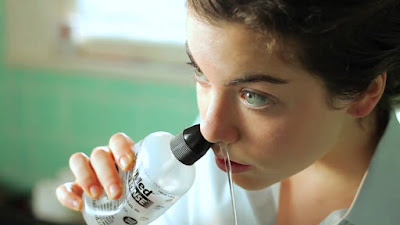 Nasal irrigation is a practice of personal hygiene with which breathing is improved.
This technique removes dirt and other debris from the nasal passages, since
impurities are carried along by the water. Occasionally, the expression jala
neti is also heard, which is a traditional yoga practice that cleans the nose
through nasal irrigation. The word jala in Sanskrit (classical Indian language)
means "water" and neti, "to guide"; therefore, jala neti
means to guide the water through the nasal passages to clean them. Here is how
it is done and what its benefits are.
Nasal irrigation is a practice of personal hygiene with which breathing is improved.
This technique removes dirt and other debris from the nasal passages, since
impurities are carried along by the water. Occasionally, the expression jala
neti is also heard, which is a traditional yoga practice that cleans the nose
through nasal irrigation. The word jala in Sanskrit (classical Indian language)
means "water" and neti, "to guide"; therefore, jala neti
means to guide the water through the nasal passages to clean them. Here is how
it is done and what its benefits are.The importance of nasal washes The use of the handkerchief dates back to the sixteenth century, but the entire mechanism of nasal cleansing is prepared to evacuate secretions from the nostrils to the throat Nasal irrigation or nasal irrigation is a practice of personal hygiene with which breathing is improved. This technique removes dirt and other debris from the nasal passages, since impurities are carried along by the water. Occasionally, the expression jala neti is also heard, which is a traditional yoga practice that cleans the nose through nasal irrigation. The word jala in Sanskrit (classical Indian language) means "water" and neti, "to guide"; therefore, jala neti means to guide the water through the nasal passages to clean them.
Here is how it is done and what its benefits are.
How to perform the nasal wash correctly
To begin with, it is
necessary to have a suitable utensil for the nasal shower. There are many neti
jars in the market. Most carry a spoon that will be very useful to prepare the
water with adequate salinity for the mucosa.
How to use a neti jar?
The steps to follow are these (it is important
to pay attention to the way you sound):
1. Fill the carafe with
warm water.
2. Add a teaspoon of sea
salt.
3. Stir to mix the water
and sea salt.
4. The head is tilted
forward, the funnel is placed in one of the holes and the head is turned to the
side, until the water passes to the other side.
5. Half of the solution
is poured into one nostril allowing it to exit through the other, breathing
through the mouth.
6. This process is
repeated on the other side.
7. Gently remove the air
through the nose to expel the rest of the water.
8. At the end of the
process, it must be incorporated and dried.
9. Subsequently, it is
important to blow your nose gently out without closing both nostrils at the
same time.
10. Finally, you have to
blow your nose again, but inwardly.
Although it seems
strange, what is commonly called "snot snot" is the most
physiological way to eliminate excess secretions from the nose. The use of the
handkerchief to clean the nose only goes back to the sixteenth century,
coinciding with the first epidemics of contagious diseases in the cities. The
hair on the nose and all the nasal cleaning mechanism is prepared to evacuate
secretions from the nasal passages to the throat.
Beware of blowing
yourself quickly and loudly! It could hurt your ears.
Common mistakes and how to solve them
The water reaches the
throat and we can not breathe. Solution: bend the head more.
The water does not come
out the other side. Solutions: bend the head more, check that the duct of the
jar is not against the septum or, if there is an excess of secretions, make
several tests throughout the day.
We have finished the
water and we still notice that the nostrils are not clean. Solution: in this
case we will repeat the process.
When we sound we hear
that the ears are covered. Solutions: we decrease the strength and pressure
when we sound, we prioritize the technique of "sucking the nasal
secretions" or we sound with both nostrils covered at the same time.
Water and secretions
continue to fall after a while of having washed our noses. Solution: in this
case we repeat the washing.
When to do a nasal wash and when it should not be done
A nasal wash should not
be applied, if there is heavy nasal bleeding, after endoscopic nasal surgery or
if swallowing problems occur.
The best time to clean
your nose is every morning, at the beginning of the day, to keep the nostrils
clean. It is also advisable to do so after being exposed to mites or allergen,
in case of being allergic, to reduce the possible symptoms. If you suffer from
sleep apnea, it is advisable to wipe your nose before going to sleep.


Aw, this was a very nice post. In concept I wish to put in writing like this additionally – taking time and actual effort to make an excellent article… however what can I say… I procrastinate alot and by no means appear to get something done. gsn casino slots
ReplyDelete